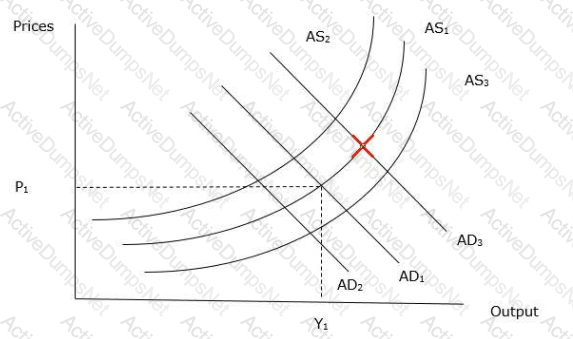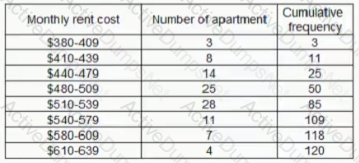CIMA BA1 Fundamentals of Business Economics Exam Practice Test
Fundamentals of Business Economics Questions and Answers
The economy of Country V is initially in equilibrium at a level of national income and employment denoted by Y, at price level denoted by P If there is an increase in aggregate demand, indicate on the graph below the new equilibrium point in the economy.

A regressive tax is defined as one where:
Quantitative easing, the purchase of government or private securities by the central banks from investors, is an example of
Atu, a new social media platform, has launched an advertising campaign directed at areas of Country X where there is a higher proportion of young people than elsewhere.
Which source is most likely to have been used by Atu to acquire this data?
'The £ has risen against other currencies since August, defying forecasters who thought that the UK's widening trade deficit must cause the £'s exchange rate to fall.'
From the above information, it can be concluded that, since August
A business has a contractual requirement to pay a sum of$6m in a foreign currency in 12 months time. It takes out a forward exchange contract from this sum.
If out of every £20 million increase in national income, £2 million is saved, £4 million is spent on imports and £4 million is paid to the government in taxation, an increase in exports of £40 million will lead to an eventual increase in national income of
Governments provide public goods, such as street lighting, because
A business analyst has configured a trend regression for the sales of company X. The following table reports the ratios between the actual quarterly sales of company X and the calculated trend, for the period of four years.

What is the seasonal component in the fourth? Give your answer to the decimal places.
Golden Crisp Cereals has calculated that its demand price elasticity is -1.4. It wants to expand in order to produce more cereal and hence increase its sales.
Which of the following are ways in which Golden Crisp Cereals could expand in the short run?
Select ALL that apply.
Company X's government has seen the the balance of payments deficit steadily rising while they have been in power.
Which of the following would be a good policy to implement to counteract this?
Other things being equal, an increase in a country's balance of payments deficit on current account means that
The company flowbo Ltd. currently owns 25 bonds with a total nominal value of £1,000. The bill rate is currently 7%. The market value of the bonds is currently 14.5% higher than the nominal value of each individual bond
plus the bill rate.
Which of these is the difference between the nominal value of the bonds plus the bill rate payout and the market value of each bond?
Express your answer in whole pounds.
ToyTown, a soft toy manufacturer, produces what it claims to be the cheapest teddy bears on the market. The graph shows the current price of a ToyTown teddy bear and its relationship to the demand for ToyTown teddy
bears.
If the price of ToyTown teddy bears were to increase, what would happen to the demand?
All of the following would be motives for a horizontal merger except one. Which ONE is the exception?
Which of the following best defines 'corporate governance'?
Merit goods are typically characterized by
When the government intervenes in the market economy to correct a market failure
Which ONE of the following is NOT a class of stakeholder?
A rise in the demand for petrol by motorists is likely to follow a rise in the price of:
Which of the following statements that refer to the price mechanism is not true?
Which ONE of the following statements about profit is true?
When a tax is imposed upon a commodity which the producers must pay to the government, this will cause the commodities?
Which of the following statements about the sources of stakeholder conflict is true?
There are waiting lists and shortages of a product. Which ONE of the following statements explains the cause of this?
All of the following would tend to lead to an industry being dominated by a small number of firms except one. Which ONE is the exception?
The 'satisfying' model of business behavior states that business will aim to:
Which of the following provides a definition of a free good?
A promoter has arranged a large outdoor concert. All the costs are fixed and there are no variable costs associated with the number of spectators attending.
Which of the following statements about the profit maximizing price is FALSE?
What is meant by the term 'mezzanine finance'?
Which theory of the firm is described by the following statement?
'The decisions of management are the result of a political maneuvering of the various stakeholders connected to the organization.'
Which of the following functions is not performed by investment exchanges such as NASDAQ, the London Stock Exchange or the New York Stock Exchange?
In a system of freely floating exchange rates the central bank and government will
Whenever a government provides health care services free of charge
All of the following are functions of a central bank except one. Which ONE is the exception?
Following a 10% reduction in the value of its currency, the volume of imports into the country falls by 10%, whilst the volume of exports rises by 15%.
Which of the following effects will occur?
Central banks fulfill all of the following functions except which?
The International Monetary Fund uses the funds at its disposal to
Which of the following have been recommended in order to prevent a repeat of the 2008 financial crisis?
The incentive for two countries to trade with each other would be reduced or removed by
(i). people in both countries having similar tastes and preferences
(ii). per capita income being much higher in one country than in the other
(iii). transport costs between the two countries exceeding the output gain from trade
(iv). the industries in both countries suffering from significant decreasing returns to scale
All of the following are sources of finance for business except which one?
Which ONE of the following would be expected to reduce the net present value of a proposed investment project?
A rise in
Which of the following organisational arrangements is an example of a multinational corporation (MNC)?
Company A owns a factory in a foreign country. Which of the following types of exchange rate risk is company A most likely to experience in relation to the value of the factory'?
Which of the following is the most likely policy response to an economic recession?
If a central bank wished to increase the supply of money and credit in the economy it would:
A business sells soft drinks at S3 a bottle and its current sales are 20,000 bottles per month. The price elasticity of demand for this product is -2 If the price is reduced to $2 70, the change in the total revenue for the business will be:
Organisations are able to achieve more than individuals can achieve because they allow people to do which THREE of the following?
A bank charges a 4% quarterly interest rate on a personal loan of $10,000
What is the effective annual amount of interest that the borrower pays on this loan? Give your answer to the nearest whole dollar.
The following table provides the frequency distribution and cumulative frequencies of the cost of monthly rent for 120 apartments. What is the percentage of apartments whose monthly rent is less than $510?

Which THREE of the following are examples of supply-side policies?
Which of the following is also known as the International Bank for Reconstruction and Development?
Based on a trade balance between Country A and Country B over a ten year period, the underlying trend of the trade balance is represent equation
-114.027 -1.47x
where x is the time period expressed in years.
Assuming an additive forecasting model, with a seasonal factor of 82 6, then the forecast for year 2016, in whole units is:

Which TWO of the following would be objectives for internal stakeholders in a profit-seeking organisation?
A government issues a security which promises to pay $100 per year indefinitely. What is it worth if the required rate of return is..
Setting a minimum wage above the equilibrium wage
Which of the following would not increase barriers to world trade?
On an aggregate demand and aggregate supply diagram, cost-push inflation is shown by
The imposition of a tariff on imported goods by a country's government will result in all of the following except one. Which ONE is the exception?
In a recession which ONE of the following would be likely to experience the largest fall in demand for its products?
Identify from the list below the financial instrument that is not a method of government borrowing:
All of the following are characteristics of a recession except which one?
Which ONE of the following best explains the statement 'In not for profit organizations money is a constraint and not a goal'?
A country has a trade deficit. The demand for its imports and exports are both price elastic. All of the following would lead to an a reduction in the country's trade deficit except which one?
As a result of a period of rapid economic growth, an economy is likely to experience all of the following except which one?
The Phillips curve shows that the government
Some not-for-profit organizations (NPOs) are required to show they are effective. Which one of the following most closely defines effective?
Which ONE of the following is an External stakeholder in a state-owned energy provider?
If a government adopted a fiscal policy of cutting its budget deficit, the aggregate demand and supply model shows that the result would be:
Which global institution is concerned with enforcing the GATT?
